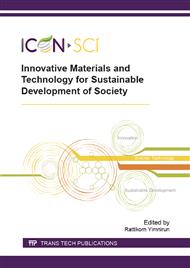[1]
L. Chih-Cheng, L. Wang-Hua, H. Chun-Yen, L. Kuo-Min and L. Yuan-Yao, Synthesis of one-dimensional ZnO nanostructures and their field emission properties, J. Phys. D: Appl. Phys. 41 (2008) 045301-045306.
Google Scholar
[2]
O. Akhavan, M. Mehrabian, K. Mirabaszadeh and R. Azimirad, Hydrothermal synthesis of ZnO nanorod arrays for photocatalytic inactivation of bacteria, J. Phys. D: Appl. Phys. 42 (2009) 225305-225315.
DOI: 10.1088/0022-3727/42/22/225305
Google Scholar
[3]
Z. L. S. Seow, A. S. W. Wong, V. Thavasi, R. Jose and S. Ramakrishna, Controlled synthesis and application of ZnO nanoparticles, nanorods and nanospheres in dye-sensitized solar cells, Nanotechnology 20 (2009) 045604-045609.
DOI: 10.1088/0957-4484/20/4/045604
Google Scholar
[4]
F. Fang, J. Futter, A. Markwitz and J. Kennedy, UV and Humidity sensing properties of ZnO nanorods prepared by the arc discharge method, Nanotechnology 20 (2009) 245502-245508.
DOI: 10.1088/0957-4484/20/24/245502
Google Scholar
[5]
I. S. Jung, H. Woong-Ki, J. L. Mi, L. Takhee, S. Henning, J. K. Dae and E. W. Mark, The influence of surface chemical dynamics on electrical and optical properties of ZnO nanowire filed effect transistors, Nanotechnology 20 (2009) 505202-505206.
DOI: 10.1088/0957-4484/20/50/505202
Google Scholar
[6]
T. Kumpika, W. Thongsuwan and P. Singjai, Optical and electrical properties of ZnO nanoparticle thin films deposited on quartz by sparking process, Thin Solid Films 516 (2008) 5640-5644.
DOI: 10.1016/j.tsf.2007.07.062
Google Scholar
[7]
H. Guannan, H. Bo, W. Suntao, L. Jing and W. Qi-Hui, Structure morphologies and luminescence properties of ZnO nanomaterials synthesized by an acidic solution process, J. Phys. D: Appl. Phys. 42 (2009) 215401-215406.
DOI: 10.1088/0022-3727/42/21/215401
Google Scholar
[8]
W. Ning, J. Li, P. Hongrui and L. Guicun, Synthesis of ZnO nanostructures composed of nanosheets with controllable morphologies, Cryst. Res. Technol. 44 (2009) 341-345.
DOI: 10.1002/crat.200800445
Google Scholar
[9]
B. Toboonsung and P. Singjai, Formation of CuO nanorods and their bundles by an electrochemical dissolution and deposition process, J. Alloys Comp. 509 (2011) 4132-4137.
DOI: 10.1016/j.jallcom.2010.12.180
Google Scholar
[10]
J. Fang, P. M. Leufke, R. Kruk, D. Wang, T. Scherer and H. Hahn, External electric field driven 3D ordering architecture of silver (I) oxide meso-superstructures, Nano Today 5 (2010) 175-182.
DOI: 10.1016/j.nantod.2010.05.002
Google Scholar
[11]
A. Matsuda, W. K. Tan, S. Furukawa and H. Muto, Morphology-control of crystallites precipitated from ZnO gel films by applying electric field during hot-water treatment, Mat. Sci. Semicon. Proc. 16 (2013) 1232-1239.
DOI: 10.1016/j.mssp.2012.12.018
Google Scholar


